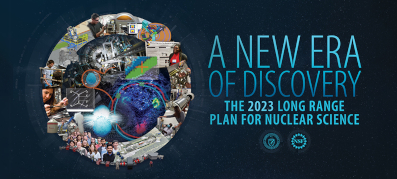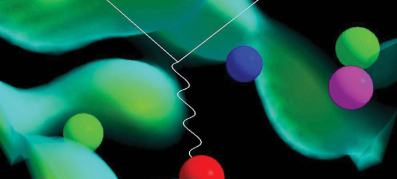NSAC release of the 2023 Long Range Plan of Nuclear Science

On October 4th, the U.S. Nuclear Science Advisory Committee (NSAC) announced the approval and release of A New Era of Discovery: The 2023 Long Range Plan for Nuclear Science.
Overview

The Physics Department and the Institute of Nuclear and Particle Physics support some of the leading research groups in this basic area of physics. Faculty members are the spokesmen for experiments that test fundamental aspects of nucleon and nuclear structure. These include experiments at the Stanford Linear Accelerator Center (SLAC) on the origin of the nucleon's spin, the details of the charge distribution of the neutron at Thomas Jefferson National Accelerator Facility (TJNAF), and a precision measurement of pion beta decay at the Paul Scherrer Institute (PSI). At SLAC the inelastic scattering of polarized electrons from polarized nucleon targets allows a detailed investigation of the spin structures of the nucleon. These measurements provide the best determination of how the quarks and gluons contribute to the fundamental spin of the nucleon. There is active research and development of high-power polarized targets, using high-field superconducting magnets, low-temperature refrigerators, and high-frequency microwaves. Electron paramagnetic resonance characterization of these targets is proceeding together with theoretical and computational modeling of local hyperfine interactions that contribute to dynamic nuclear polarization. At TJNAF an extensive series of experiments has been approved, including a measurement of the electric charge form factor of the neutron. The experimental measurements are complemented by strong theoretical support in the Department. This theoretical effort involves work in relativistic chiral quark models; spontaneous chiral symmetry breaking; quantum theories based on light-front formalism; and perturbative quantum chromodynamics (QCD) phenomenology, including studies of power corrections to the nucleon/nuclear structure functions, quark-hadron duality and low Bjorken x physics.
The measurement of both the electron and hadron in electromagnetic nuclear reactions will provide new information about possible modifications of nucleon structure within the nuclear medium. The additional ability to measure the spin of the recoiling hadron with a polarimeter allows a determination of nuclear dynamics not accessible by standard methods.
Experiments at TJNAF use resonant pion production from the nucleon to study the structure and inelastic response of this fundamental three-quark system. Electro-production of excited states of the nucleon constitutes a major part of the research program for the large acceptance detector (CLAS). This detector consists of a large toroidal superconducting magnet, with a variety of detectors to track and identify particles over a large solid angle. Polarized nucleon targets have been developed for use in this detector.
The study of basic symmetries and conservation laws can provide some of the most precise information on the dynamics of the two short-range interactions, the electroweak and the strong. A precision measurement of the pion beta decay rate is taking place at PSI in Switzerland. This measurement provides the best theoretical means to study the weak coupling between the up and down quarks.
A program of experiments at the Laser Electron Gamma Source (LEGS) at Brookhaven National Laboratory examines the non-perturbative regime of QCD, including the possible resonant distortion of the nucleon. This work is complemented by research at the newly-commissioned low energy polarized photon source at the Triangle Universities Nuclear Laboratory (TUNL).
Personnel
 Peter Arnold
Peter ArnoldProf. Arnold studies the theory of the strong, weak, and electromagnetic interactions at extremely high, relativistic temperatures, such as in the very early Universe (less than a millionth of a second after the Big Bang) or in relativistic collisions in heavy ion accelerators. Topics he has studied include investigating why there is significantly more matter than anti-matter in the Universe and understanding the properties of quark-gluon plasmas. The theoretical methods used for these very high energy problems (as much as a quadrillion degrees Kelvin) can also be applied to certain ... More>
 Stefan Baeßler
Stefan BaeßlerProfessor Baeßler does research in fundamental symmetries, that is, precision tests of the Standard Model of Elementary Particles. His main activities are devoted to physics with cold neutrons at the SNS in Oak Ridge/Tennessee. He conducts experiments that study neutron beta decay (Nab and pNab). In addition, he is testing gravity with cold and ultracold neutrons at the ILL in Grenoble/France (GRANIT), and he is determining the magnetic moment of the muon (g-2) at Fermilab and ... More>
 Gordon D Cates, Jr.
Gordon D Cates, Jr.Professor Cates conducts research in three diverse areas spanning atomic, nuclear, and medical physics. Unifying these activities is the use of optical pumping and spin exchange, techniques that make it possible to polarize the spins of electrons, atoms and nuclei using light sources such as lasers. Critical to such research is the study of spin interactions during atomic collisions, spin-relaxation at surfaces, and numerous aspects of laser physics. More>
 Dustin M. Keller
Dustin M. KellerProfessor Keller conducts research in spin physics at the intersection of high-energy, nuclear, and condensed matter physics, with interests in hadron spin structure, physics beyond the standard model, spin-sensitive phenomena, and mapping the inner structure of composite spin systems. This research involves the study of quark and gluon dynamics as well as the study of spin degrees of freedom to probe polarized observables. This research could also be ... More>
 Simonetta Liuti
Simonetta LiutiProfessor Liuti´s research involves theoretical studies of the quark and gluon internal dynamics of the proton. The fundamental interactions of quarks and gluons are governed by the beautifully concise Lagrangian of quantum chromodynamics (QCD), however, to be able to understand the mechanisms generating the proton mass, spin and mechanical properties in terms of quarks and gluons is one of the biggest challenges in physics today. Professor Liuti's work has been focused on understanding how the nucleon gets its spin from its fundamental ... More>
 Nilanga Liyanage
Nilanga LiyanageIn the so called confinement region quarks interact strongly to form protons and neutrons. Understanding the structure of the nucleon in the confinement region in terms of Quantum Chromo Dynamics (QCD), the fundamental theory governing the strong interaction between quarks, presents a great challenge to physicists. Professor Liyanage´s research is focused on understanding the neutron structure. He is the principal spokesperson of a recently completed Jefferson Lab experiment, E01-012, that performed a precision measurement of the neutron spin structure in the nucleon resonance ... More>
 Kent D. Paschke
Kent D. PaschkeProfessor Paschke’s research activity focuses on precision measurements of parity-violation in electron scattering at Jefferson Lab, in Newport News Virginia. These measurements have proven to be a useful tool for the study of the building blocks of the atomic nucleus and for testing the completeness of the Standard Model of electroweak interactions. A recently completed series of experiments address a range of topics, including strange quarks in nuclei, nuclear structure in a 208Pb nucleus, and the electroweak coupling of the nucleons. Prof. Paschke is also actively ... More>
 Dinko Počanić
Dinko PočanićProfessor Počanić is studying basic symmetries and conservation laws manifest at low and intermediate energies, with the aim of obtaining new stringent constraints on the dynamics of the two fundamental short-range interactions: the electroweak and the strong. This work requires precise measurements of the elementary decay and scattering processes typically involving the simplest particles in nature: mesons, leptons, and nucleons. More>
 Diana Vaman
Diana VamanMy research in theoretical particle physics is based on string theory, and I am especially interested in the connections between gauge and string theories. More>
 Xiaochao Zheng
Xiaochao ZhengProfessor Zheng conducts research at the Thomas Jefferson National Accelerator Facility (JLab). Her research interest includes study of the nucleon structure, especially the spin structure of the neutron using a polarized 3He target. The nucleon structure is determined by how quarks and gluons interact with each other, thus such information could reveal some fundamental properties of the strong interaction and QCD. Another major aspect of Prof. Zheng's research is parity violation (PV) in electron deep inelastic scattering (DIS). By measuring the PVDIS asymmetry off a hydrogen and a ... More>
 Physics at Virginia
Physics at Virginia